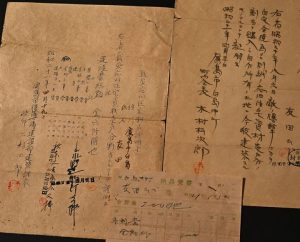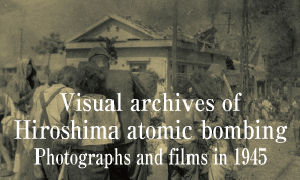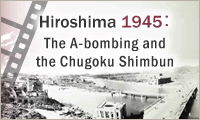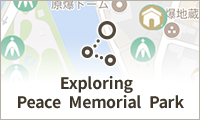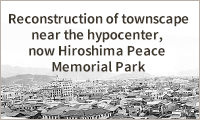Documenting of Hiroshima, 1946: In April, A-bombed mother and daughter rebuild their home on their own
Apr. 20, 2025
by Maho Yamamoto, Staff Writer
In April, 1946, Sumiko Tomoda, then 19, (who died at age of 93 in 2021) worked on the reconstruction of her home in Hakushimanaka-machi (now part of Naka Ward in Hiroshima City). Her previous house, which had stood on the same site, was completely destroyed and burned down after the atomic bombing. Ms. Tomoda also lost three of her family members because of the bombing, and was left alone with her mother Hide (who died at age of 86 in 1981).
The reconstruction cost was six thousand yen. When housing materials were distributed by the city’s restoration department on April 19, 1946, she pulled a large cart to pick them up in Ujina. On April 20, the building certificate was also issued under the name of the president of her neighborhood association, who wrote, “The local association’s president proves the fact that Ms. Tomoda will build a home on the land she owns.”
The mother and daughter would constantly visit the burned ruins of their home from a mountain cottage they owned in Ushita, Hiroshima City, a base for their post-war living. In 2011, when she donated a series of documents related to the housing reconstruction, she explained, “Shedding tears, I piled up rooftiles on the ruined site one after the other.” She then added, “Even though I said my home was rebuilt, it was mere a shack constructed by a carpenter I knew.”
Ms. Tomoda experienced the atomic bombing at the fifth Divisional Headquarters located within the Hiroshima Castle, where she worked. The headquarters was about 750 meters away from the hypocenter. Even though she was hit by fragments of broken glass in the face and legs, she fled to Ushita with her friend after the bombing. Her mother was able to survive at an air-raid shelter made in her home.
Her father, Torakichi Tomoda, on the other hand, then 55, who did work related to the military, became bedridden after he experienced the atomic bombing, and died on October 28, 1945. Her younger brother, Koei Tomoda, then 16, who had been near the tax office in Hacchobori at the time of the atomic bombing, had a high fever and passed away on August 27. Another younger brother, Sadanaru Tomoda, then 12, a first-year student at Hiroshima Municipal Middle School (now Motomachi High School) went missing having been mobilized to do work near Dobashi.
Sumiko lived in the same place until her last years by rebuilding her home several times. Her grandson Yoshiki Tomoda, 49, resident of Higashihiroshima City, Hiroshima Prefecture, recalled his memory of her and said, “When I was a child, my grandmother and I would go and look at the lists of A-bomb victims together every year.”
According to the Hiroshima City Guide published in fiscal 1946, a survey conducted in August in that year reported 32,242 houses were rebuilt. Its breakdown shows 1,585 cases of new house construction, 18,486 homes repaired, and 12,171 shacks built. In the Motomachi area (now part of Naka Ward, Hiroshima) located near the hypocenter, the city government began to construct residences which were then in short supply. With a plan to partially utilize the area for park, Hiroshima Prefectural Government joined the city’s project, completing about 1,800 publicly-financed housings until 1949.
(Originally published on April 20, 2025)
In April, 1946, Sumiko Tomoda, then 19, (who died at age of 93 in 2021) worked on the reconstruction of her home in Hakushimanaka-machi (now part of Naka Ward in Hiroshima City). Her previous house, which had stood on the same site, was completely destroyed and burned down after the atomic bombing. Ms. Tomoda also lost three of her family members because of the bombing, and was left alone with her mother Hide (who died at age of 86 in 1981).
The reconstruction cost was six thousand yen. When housing materials were distributed by the city’s restoration department on April 19, 1946, she pulled a large cart to pick them up in Ujina. On April 20, the building certificate was also issued under the name of the president of her neighborhood association, who wrote, “The local association’s president proves the fact that Ms. Tomoda will build a home on the land she owns.”
The mother and daughter would constantly visit the burned ruins of their home from a mountain cottage they owned in Ushita, Hiroshima City, a base for their post-war living. In 2011, when she donated a series of documents related to the housing reconstruction, she explained, “Shedding tears, I piled up rooftiles on the ruined site one after the other.” She then added, “Even though I said my home was rebuilt, it was mere a shack constructed by a carpenter I knew.”
Ms. Tomoda experienced the atomic bombing at the fifth Divisional Headquarters located within the Hiroshima Castle, where she worked. The headquarters was about 750 meters away from the hypocenter. Even though she was hit by fragments of broken glass in the face and legs, she fled to Ushita with her friend after the bombing. Her mother was able to survive at an air-raid shelter made in her home.
Her father, Torakichi Tomoda, on the other hand, then 55, who did work related to the military, became bedridden after he experienced the atomic bombing, and died on October 28, 1945. Her younger brother, Koei Tomoda, then 16, who had been near the tax office in Hacchobori at the time of the atomic bombing, had a high fever and passed away on August 27. Another younger brother, Sadanaru Tomoda, then 12, a first-year student at Hiroshima Municipal Middle School (now Motomachi High School) went missing having been mobilized to do work near Dobashi.
Sumiko lived in the same place until her last years by rebuilding her home several times. Her grandson Yoshiki Tomoda, 49, resident of Higashihiroshima City, Hiroshima Prefecture, recalled his memory of her and said, “When I was a child, my grandmother and I would go and look at the lists of A-bomb victims together every year.”
According to the Hiroshima City Guide published in fiscal 1946, a survey conducted in August in that year reported 32,242 houses were rebuilt. Its breakdown shows 1,585 cases of new house construction, 18,486 homes repaired, and 12,171 shacks built. In the Motomachi area (now part of Naka Ward, Hiroshima) located near the hypocenter, the city government began to construct residences which were then in short supply. With a plan to partially utilize the area for park, Hiroshima Prefectural Government joined the city’s project, completing about 1,800 publicly-financed housings until 1949.
(Originally published on April 20, 2025)

